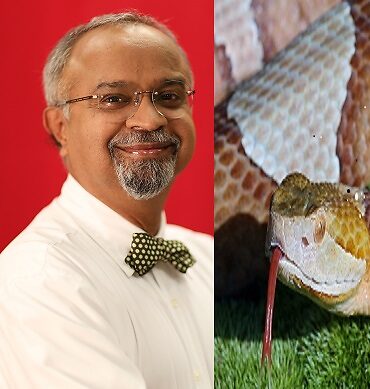Seminar "Venoms and Toxins: A Source of Inspiration " by Prof. Manjunatha Kini, National University of Singapore

Date
Location
Description
Ecology and Evolution (Mikheyev) Unit would like to invite you to a seminar by Prof. Manjunatha Kini.
===============================
Date: Monday, November 16th, 2015
Time:11:00-12:00
Venue: Seminar Room C209, Center Building
===============================
Speaker: Professor Manjunatha Kini, Department of Biological Sciences, Faculty of Science, National University of Singapore
Title: " " Venoms and Toxins: A Source of Inspiration ".
Abstract:
Venoms and toxins have involved in various animals to assist them in the immobilization of prey and food capture. We have been interested in structure-function relationships, mechanism of action and evolution of protein toxins. Over the last several decades, toxin research has contributed significantly to both basic and applied sciences. In my talk, I will discuss the contributions of toxin research in three key areas:
- Protein folding: c/l-conotoxins differ from classical a-conotoxins in their disulfide pairings and fold, despite the conserved location of cysteine residues. By systematic analyses followed by folding studies, we identified two key structural features – C-terminal amidation and a conserved Pro residue in intercysteine loop 1 – that determine the globular folding with C1-C3 and C2-C4 disulfide pairings in a-conotoxins and ribbon folding with C1-C4 and C2-C3 disulfide pairings in c/l-conotoxins. Using similar strategies, we also identified the importance of a single conserved hydrophobic residue in the nucleation of hydrophobic core and proper folding in epidermal growth factor (EGF) domains;
- Drug delivery: Candoxin block abgd acetylcholine receptors reversibly but a7 receptors irreversibly. The functional site (loop II) of candoxin was used to deliver PEG-PLA micelle containing anticancer drug (Paclitaxel) to glioblastoma in brain; and
- Drug design and development: Variegin is a novel class of thrombin inhibitor isolated from tropical bont tick. It is a highly specific and potent inhibitor of thrombin. The structure of thrombin-variegin complex indicates that the variegin inhibits thrombin by a novel mechanism; it disrupts the catalytic triad and charge relay system. Based on the structure and prior knowledge, we designed shorter, more potent, tunable inhibitors of thrombin.
We hope to see many of you at the seminar.
Sincerely,
Yoko Fujitomi
Ecology and Evolution (Mikheyev) Unit
Subscribe to the OIST Calendar: Right-click to download, then open in your calendar application.



